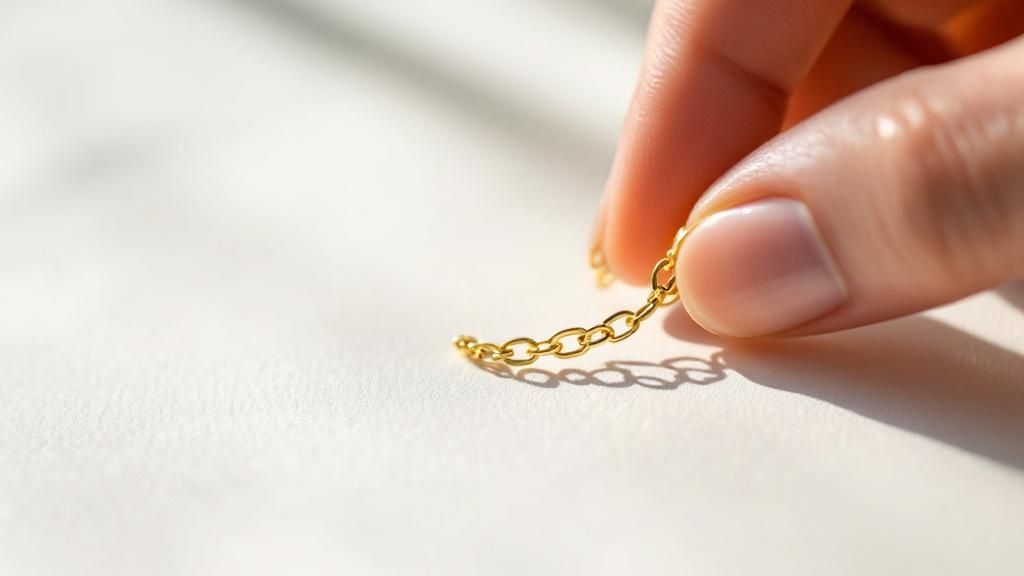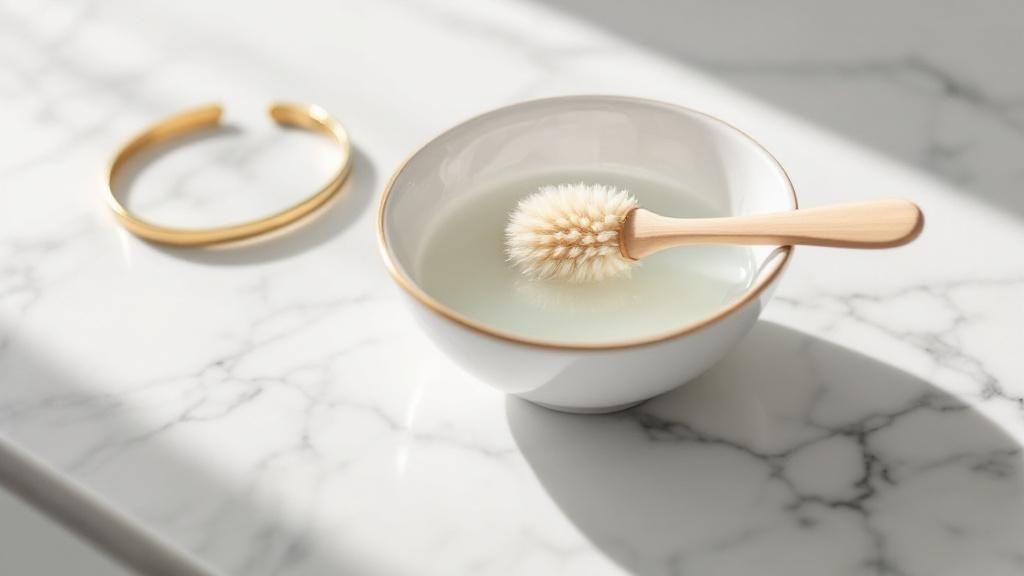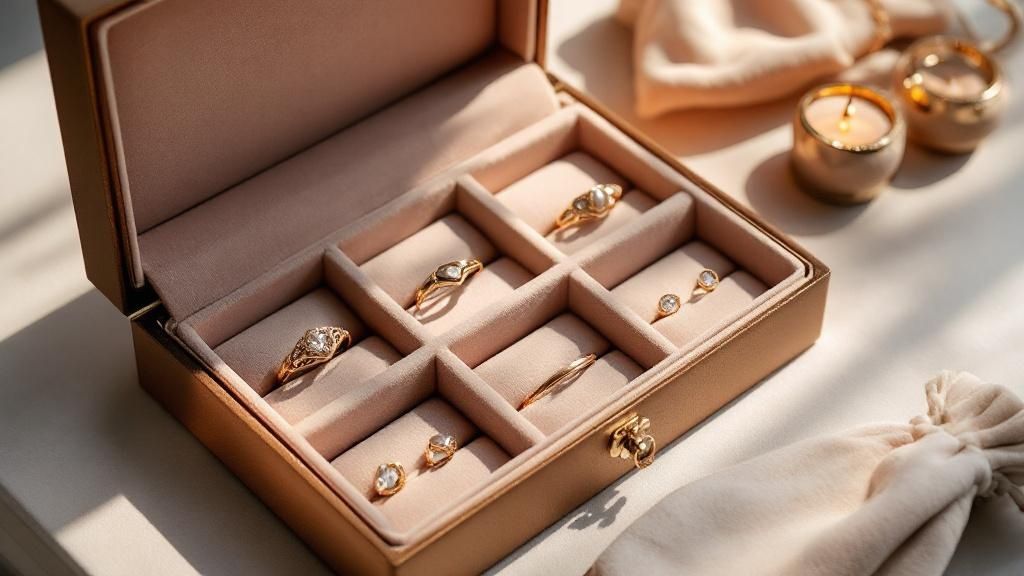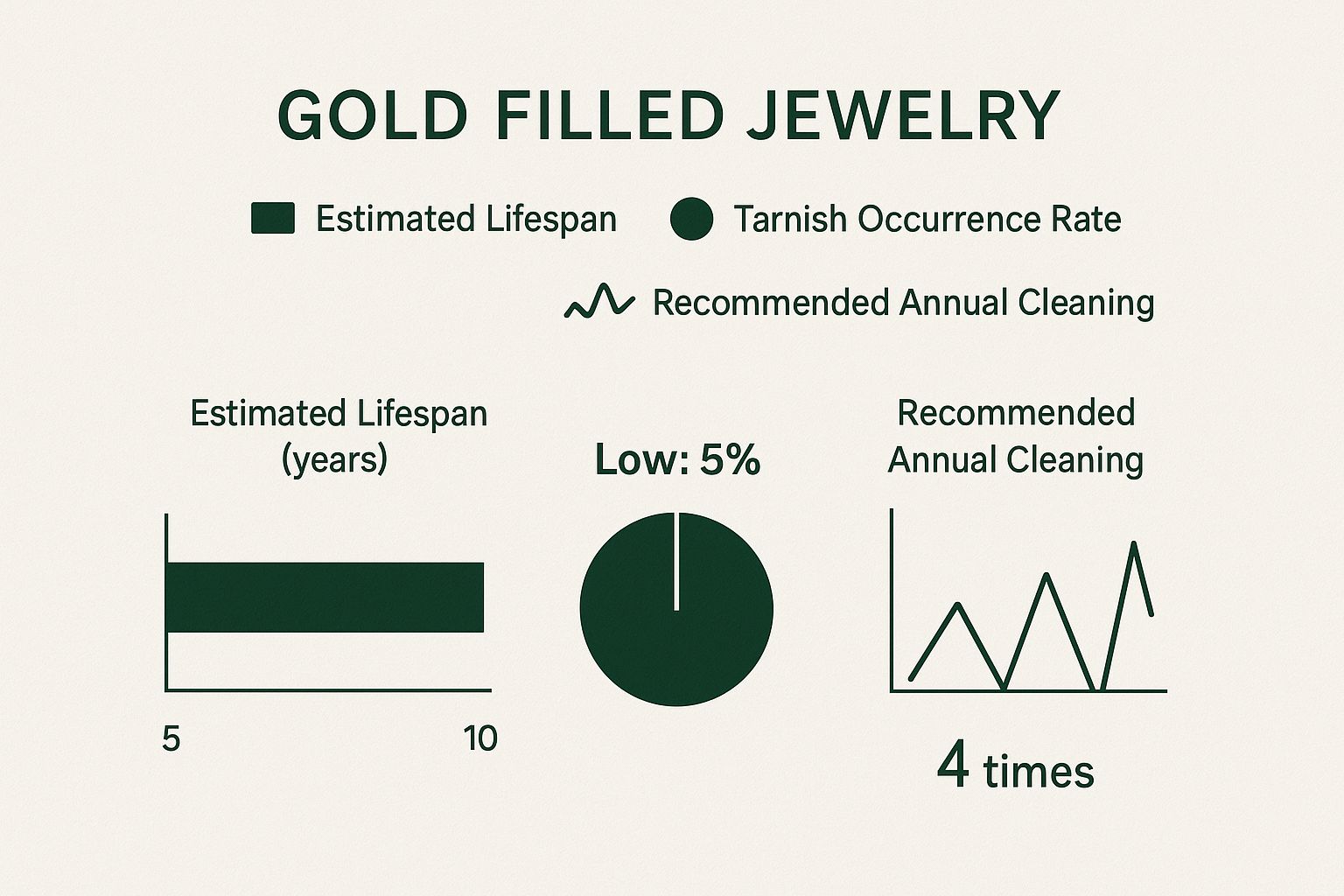- Continue Shopping
- Your Cart is Empty
Your Guide to Gold Filled Jewelry Care
Before we get into the nitty-gritty of cleaning and storing your pieces, let's talk about what gold-filled jewelry actually is. It's a fantastic middle-ground in the jewelry world—a thick, durable layer of real gold that's been permanently bonded to a quality base metal. This smart construction gives you the rich look and feel of solid gold without the hefty price tag.
What Is Gold Filled Jewelry, Really?

Knowing what your jewelry is made of is the first step to taking good care of it. Gold-filled isn't the same as gold-plated, which has a microscopic layer of gold that can rub off in a heartbeat. Instead, gold-filled jewelry is built to last. The process involves using intense heat and pressure to mechanically bond a substantial layer of gold to a core, which is usually jeweler's brass.
This creates a permanent bond that won’t flake or peel under normal wear and tear. In fact, to even be called "gold-filled," a piece legally has to be made up of at least 5% (or 1/20) gold by weight. That's a world away from gold-plated items, which often contain less than 0.05% gold.
Why This Matters for Longevity
That thick outer layer of gold is your jewelry's best friend. It’s what gives it resilience, acting as a tough barrier that protects the inner base metal from tarnish and exposure to the elements. This is precisely why, with the right care, your favorite pieces can stay beautiful for years and years.
With consistent and proper maintenance, gold-filled jewelry can last a decade or even longer. It’s the perfect middle ground between the affordability of plated items and the heirloom quality of solid gold.
Simple, consistent habits—like gentle cleaning and smart storage—are all it takes to protect that finish. Once you understand the "why" behind its construction, the care steps we'll cover next make perfect sense. If you want to dive deeper, you can explore our full guide on how to care for gold filled jewelry.
How Long Can It Truly Last?
Given its superior construction, the lifespan of gold-filled jewelry is genuinely impressive. Its durability makes it a fantastic choice for the pieces you wear every day, from delicate necklaces to statement earrings. The main things that influence how long it lasts are the thickness of the gold layer, how you wear it, and your cleaning routine.
Jewelry experts and material studies agree: with a little bit of attention, these beautiful pieces can keep their brilliant shine for 10 to 30 years. That kind of long-term value makes it a smart and beautiful addition to any collection.
Building Your Daily Care Habit

The real secret to making your gold-filled pieces last isn't some intense, once-a-month cleaning session. It’s the little things you do every day. These small, consistent habits take just seconds but they're incredibly effective at preventing the gradual buildup that eventually dulls that beautiful shine.
Here’s a simple rule of thumb I always share: your jewelry should be the last thing you put on before you head out the door, and the first thing you take off when you get home. This one principle creates a powerful shield between your favorite pieces and the chemicals that can seriously damage them.
The "Last On, First Off" Rule
Think about your morning routine. Lotions, perfumes, hairspray, and even makeup are full of chemicals and oils that are kryptonite for your jewelry. When they come into contact with the gold layer, they leave behind a residue that builds up, dulls the luster, and can even speed up tarnishing.
Putting your jewelry on after your products have settled makes a huge difference. For instance, spritz your perfume, wait a minute for it to dry, and then put on your necklace. That tiny pause is a game-changer.
Likewise, taking your pieces off as soon as you get home keeps them safe. It prevents them from getting snagged while you're cooking dinner, exposed to sweat from an evening workout, or doused in household cleaners.
This single habit—"last on, first off"—is probably the most impactful thing you can do. It doesn't cost a dime or require any special tools, just a little bit of mindfulness.
Your End-of-Day Wipe-Down
Another quick ritual to get into is giving your jewelry a gentle wipe-down before you put it away for the night. As you go about your day, your pieces collect everything from skin oils and sweat to dust and pollution. A quick wipe removes all that surface grime before it has a chance to cause real problems.
A microfiber cloth, like the one you'd use for glasses, is perfect for this. Steer clear of paper towels or tissues. You might not think so, but their fibers can be abrasive and leave behind micro-scratches on the gold surface. This daily wipe is especially important for the pieces you wear all the time, like a go-to chain or your everyday rings.
Most jewelry experts agree that taking off your pieces before sleeping or any strenuous, sweaty activity is non-negotiable for preventing abrasion and corrosion. A quick wipe-down after each wear is part of that professional-grade care. You can find more great insights on this routine over at GLDN.com.
How to Deep Clean Your Jewelry Without Damage

While a quick daily wipe-down is great for surface-level dust, every so often your jewelry needs a little more attention. Think of this as a spa day for your favorite pieces—a chance to get into all the nooks and crannies where oils, lotions, and life’s general grime tend to build up.
This deeper clean is all about restoring that brilliant shine without reaching for harsh chemicals that could harm the precious gold layer. And the best part? You almost certainly have everything you need right in your kitchen. It’s all in the technique.
Creating Your Gentle Cleaning Solution
Forget fancy jewelry cleaners. All you need is a bowl of warm water and a few drops of a mild, phosphate-free dish soap. That’s it. This simple mix is all it takes to cut through residue without being harsh on the gold.
Just make sure the water is lukewarm, not hot, as extreme temperatures can potentially weaken the bond between the gold and the base metal over time. You’ll also want to double-check that your soap is a simple one—no heavy moisturizers or aggressive detergents, which can leave a dull film behind.
Pro Tip: Whatever you do, never use toothpaste or baking soda. I’ve seen people try this, and it’s a fast track to disappointment. These are abrasives that will physically scratch and wear down the gold layer, permanently dulling the finish and potentially exposing the brass core.
The Art of Gentle Scrubbing
With your cleaning solution ready, it's time to get into those tricky spots. Buildup loves to hide in chain links, around clasps, and behind settings. Your secret weapon here is an ultra-soft toothbrush. A baby toothbrush is absolutely perfect for this, as the bristles are incredibly gentle.
Here's my go-to process for a safe, effective clean:
- Give It a Quick Soak: Let your pieces rest in the soapy water for about 5-10 minutes. This isn't about soaking it for hours; it's just enough time to loosen up any stubborn grime, so you don't have to scrub hard.
- Brush with Care: Take your soft brush and gently go over the jewelry. I like to use small, circular motions, especially on detailed areas. Think of it more like dusting a fragile heirloom than scrubbing a pan.
- Rinse It All Off: Once you're done brushing, rinse each piece thoroughly under clean, lukewarm running water. You want to make sure every last bit of soap is gone, otherwise, it can dry into a cloudy film.
The Final, Crucial Steps
Drying your jewelry properly is just as important as washing it. Any moisture left behind can cause water spots, and if you store a piece while it's still damp, you're inviting tarnish.
Right after rinsing, place your jewelry on a soft, lint-free cloth—microfiber is ideal. Gently pat each piece completely dry, paying extra attention to chain links and stone settings where water can get trapped. As a final precaution, I always let my pieces air dry for another hour or so before putting them away.
This last step ensures your jewelry is perfectly clean, dry, and ready to shine. For a more comprehensive look at different cleaning techniques, check out our guide on how to clean gold-filled jewelry.
Common Mistakes That Can Ruin Your Jewelry
Knowing the right way to care for your jewelry is half the battle, but understanding what not to do is just as critical. I’ve seen so many well-intentioned owners accidentally cause permanent damage to their beautiful gold-filled pieces through simple, avoidable mistakes. These slip-ups can strip away the precious gold layer, leading to discoloration and irreversible harm.
One of the most common culprits? Harsh chemicals. Think about jumping into a swimming pool or hot tub while wearing your favorite gold-filled necklace. The chlorine in that water is incredibly corrosive and can quickly break down the gold, leaving it dull and pitted. This isn't something a quick polish can fix; the damage is often permanent.
The same goes for household chores. If you're wearing your rings while cleaning with products containing bleach, ammonia, or other harsh detergents, you're on a fast track to ruining them. These chemicals are designed to eat away at tough grime, and unfortunately, they'll do the same to the delicate finish on your jewelry.
Abrasives and Other Hidden Dangers
Another major pitfall I see all the time is using abrasive materials for cleaning. It might seem like a good idea to grab something with a little grit—like baking soda or even toothpaste—to scrub away tarnish. In reality, this is one of the worst things you can do.
These substances act like fine sandpaper, literally scratching and wearing away the thick layer of gold. Over time, this scrubbing will expose the brass core underneath, which will tarnish quickly and can even cause skin reactions in some people. Instead of restoring that beautiful shine, you're actually removing the very thing that makes the piece valuable. If you're dealing with discoloration, it's far better to learn the right way by checking out a guide on how to clean tarnished jewelry to ensure you're using safe methods.
Think of the gold layer as a shield. Every time you use an abrasive cleaner, you're thinning that shield, making it more vulnerable to damage. Protect it by sticking to gentle, non-abrasive methods only.
Finally, while ultrasonic cleaners sound like a sophisticated, high-tech solution, they can be risky for gold-filled items. The intense vibrations can sometimes weaken the bond between the gold and the base metal, especially if there are any microscopic imperfections in the piece.
Unless you are absolutely certain the cleaning solution is safe for gold-filled jewelry and you're watching it like a hawk, it’s a tool best left to professional jewelers who know how to manage the risks. For at-home care, a simple soap-and-water soak is a much safer bet.
Smart Storage to Prevent Scratches and Tarnish
Where you keep your jewelry when you're not wearing it matters just as much as how you clean it. Honestly, this is where most damage happens. Proper storage is your first line of defense against the two biggest culprits: scratches from other jewelry and tarnish from humidity and air.
Tossing your pieces into a single drawer or a pretty dish on your dresser is a recipe for disaster. I've seen it countless times—tangled chains, scuffed surfaces, and lost earrings.
Think about it. Gold-filled jewelry has a wonderfully thick, durable layer of gold, but it's not invincible. When a delicate chain gets scraped by a heavy ring or the sharp edge of a crystal earring, it creates tiny, permanent scratches. Over time, those little abrasions wear down the gold layer, dulling its shine and shortening its life.
Create a Safe Haven for Your Pieces
The ideal storage spot is cool, dry, and separate. Humidity is the main driver behind tarnish, so the bathroom is the absolute worst place to keep your jewelry. All that steam from the shower creates the perfect storm for discoloration. Instead, find a home for your pieces in your bedroom or closet.
Here are a few of my go-to storage methods that work for any collection size or budget:
- Soft-Lined Jewelry Box with Dividers: This is the classic for a reason. A box with individual compartments keeps everything from touching, which is the key to preventing scratches. The soft velvet or felt lining adds a nice layer of cushioning.
- Anti-Tarnish Pouches: These are fantastic, especially for your most cherished pieces or items you don't wear often. The fabric is treated with materials that absorb the airborne pollutants that cause tarnish. They're a simple, low-cost upgrade for extra protection.
- Simple Airtight Bags: On a budget? Small, individual ziplock-style bags work surprisingly well. Just be sure to squeeze out as much air as possible before sealing the bag. This creates a mini-vacuum that keeps out moisture. The golden rule here is one piece per bag to stop them from scratching each other.
To help you decide, let's break down the most common storage solutions.
Comparing Your Jewelry Storage Options
This table compares how different storage options stack up when it comes to preventing tarnish and physical damage.
| Storage Method | Tarnish Protection | Scratch Protection | Best For |
|---|---|---|---|
| Jewelry Box | Moderate | Excellent | Daily-wear items, easy access |
| Anti-Tarnish Pouch | Excellent | Good | Special occasion pieces, long-term storage |
| Airtight Bags | Good | Excellent | Budget-friendly organizing, travel |
| Open Dish/Tray | Poor | Poor | Storing only the piece you wore that day |
Ultimately, a combination of these methods often works best. Use a jewelry box for your everyday favorites and pouches for everything else.

The bottom line is that with a little care, gold-filled items can last for years with a very low risk of tarnishing. A good cleaning just a few times a year is all it takes to keep them brilliant.
Storing Jewelry for Travel
Taking your jewelry on the road presents a whole new set of challenges. A travel bag can cause more damage in a few days—from tangled necklaces to lost studs—than months of normal wear. Learning how to pack jewelry safely for travel is a skill that will save you a lot of heartache, whether you're a frequent flyer or just heading out for the weekend.
Travel Tip: Here's a brilliant little hack for necklaces: thread the chain through a plastic drinking straw and then fasten the clasp. The straw acts as a splint, making it physically impossible for the chain to knot itself up in your bag.
At the end of the day, the goal is to create a system that protects each piece individually. Storing your jewelry with a bit of thought is a simple habit that pays off big, ensuring your collection stays organized, safe, and ready to wear for years.
Your Gold-Filled Jewelry Questions, Answered
Even when you've got your daily care routine down, specific questions are bound to come up. It's totally normal to second-guess yourself when it comes to protecting your favorite pieces. I've heard just about every question in the book, so think of this as your go-to guide for those tricky situations.
Let's dive into some of the most common concerns I hear from fellow jewelry lovers.
Is My Dull Jewelry Ruined Forever?
This is a big one. You look down at your necklace, and it’s lost that beautiful shine it had when you first got it. The immediate fear is that the gold has worn off.
Take a deep breath—it’s almost certainly not ruined! In nearly every case I've seen, that dull, cloudy look isn't permanent damage. It’s just buildup. A thin film of residue from lotions, natural skin oils, soaps, and even everyday air pollution can easily coat the surface, hiding its gorgeous luster.
Before you panic, the very first thing to do is give it a gentle but thorough deep clean. That simple bath in warm water with a drop of mild soap we talked about earlier works wonders. Honestly, nine times out of ten, that's all it takes to cut through the grime and bring the sparkle right back.
The Great Shower Debate
"Can I wear my gold-filled jewelry in the shower?" I get asked this constantly. While these pieces are quite durable and won’t be destroyed by a single accidental shower, I really advise against making it a daily habit.
Here’s the thing:
- The Soap Scum Factor: Shampoos, conditioners, and body washes are the biggest culprits. They leave behind a residue that builds up and dulls that beautiful gold surface, meaning you'll have to clean it way more often.
- Hard Water Woes: If your home has hard water, the mineral deposits can create a stubborn, cloudy film on your jewelry that’s a real pain to remove.
- Hidden Chemicals: Some medicated or heavily fragranced soaps contain ingredients that, over many repeated exposures, could potentially react with the gold.
It takes two seconds to take your pieces off before you hop in. It’s a simple, proactive step that will pay off big time by keeping your jewelry brighter for much, much longer.
It's all about understanding the difference between "water-resistant" and "waterproof." Gold-filled jewelry can absolutely handle occasional splashes. It's the constant exposure to the chemicals in the water—like soaps or pool chlorine—that you want to avoid to keep it looking its best.
How Is It Different from Gold Plated?
When it comes to care, the difference is all about durability. Gold-filled jewelry has a substantial layer of real gold that’s mechanically bonded to a base metal core. By law, this gold layer must make up at least 5% of the item's total weight. This thick, durable layer can easily handle regular, gentle cleaning without wearing away.
Gold-plated jewelry is a different story. It has an incredibly thin layer of gold—often less than 0.05% of its weight—that's applied through electroplating. This layer is so delicate that it can literally be rubbed off with too much friction or harsh cleaning. Our gentle cleaning method is safe for both, but you can feel much more confident cleaning your gold-filled pieces.
Should I Use a Polishing Cloth?
Yes, but you need to be smart about it. A good polishing cloth designed specifically for gold is a fantastic tool for getting rid of stubborn tarnish that a simple wash can’t tackle.
But—and this is important—these cloths are slightly abrasive by design. That's how they work. For bringing back a daily shine, your best and safest bet is a simple, soft microfiber cloth. Save the polishing cloth for when you really need it. Over-polishing, especially over many years, can slowly wear down even the thickest gold layer. Think of it as a special treatment, not a daily go-to.
At EFYTAL Jewelry, we believe that the love you put into caring for your jewelry helps preserve the memories they represent. Explore our collections to find your next meaningful, handcrafted piece.
Discover Your Perfect Keepsake at EFYTAL.com





